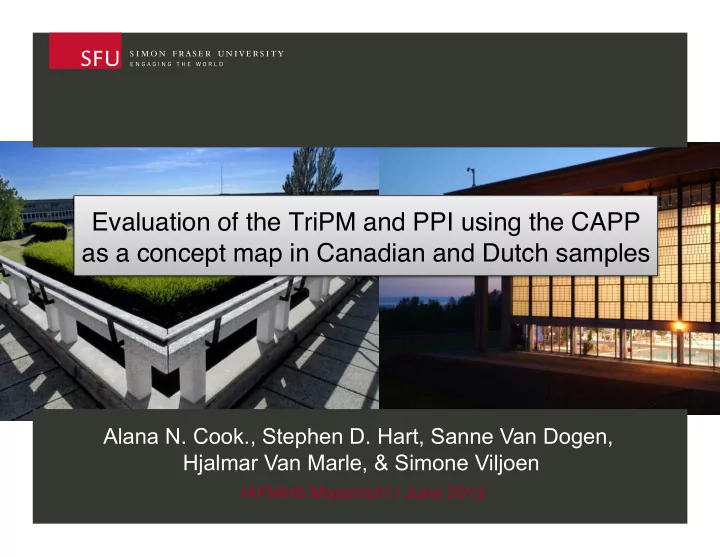

Evaluation of the TriPM and PPI using the CAPP as a concept map in Canadian and Dutch samples � Alana N. Cook., Stephen D. Hart, Sanne Van Dogen, Hjalmar Van Marle, & Simone Viljoen IAFMHS Maastricht | June 2013 �
CONCEPTULIZATION Psychopathy is a personality disorder. Traits of Psychopathic Personality Disorder: are heterogeneous are complex are ‘continuous’ not ‘categorical’ change overtime mimicked by other conditions differ in expression across gender, age & culture inherently contradict self-report in youth? SFU Psychology �
Concept ≠ Operational Definition SFU Psychology �
Comprehensive Assessment of Psychopathic Personality CAPP COMPREHENSIVE � • Domains (e.g., attachment & cognitive) � DYNAMIC � • Current severity & impairment � (Cooke, Hart, Logan, Michie, 2004) SFU Psychology �
Comprehensive Assessment of Psychopathic Personality CAPP SFU Psychology �
Comprehensive Assessment of Psychopathic Personality SFU Psychology �
Big Five Personality Research Openness � Neuroticism � Conscientiousness � Agreeableness � Extraversion � SFU Psychology �
METHOD Self-report on CAPP Traits, PPI:SF/PPI-R, & TriPM CANADIAN � • N = 322 � • 40% Male � • M age 20, SD = 2.00, range 17-23 � DUTCH � • N = 92 � • 28% Male � • M age 21, SD = 4.62, range 17-47 � SFU Psychology �
Results: TOTAL SCORES WERE SIG. CORRELATED CANADIAN � PPI:SF Total � TriPM Total � CAPP Total � .50** � .57** � DUTCH � PPI-R Total � TriPM Total � CAPP Total � .70** � .66** � ** p < .01 SFU Psychology �
Results: PPI TOTAL SCORES WERE SIG. CORRELATED with CAPP Domains DUTCH � CANADIAN � PPI:SF Total � TriPm Total � PPI:SF Total � TriPm Total � CAPP Total � .50** � .57** � .70** � .66** � CAPP Attachment � .38** � .46** � .37** � .42** � CAPP Behaviour � .58** � .64** � .71** � .68** � CAPP Cognitive � .34** � .40** � .47** � .48** � CAPP Dominance � .46** � .52** � .61** � .57** � CAPP Emotional � .23** � .33** � .53** � .49** � CAPP Self � .40** � .43** � .64** � .53** � CAPP Foils � -.34** � -.32* � -.27* � -.27* � * p < .05 ; ** p < .01 SFU Psychology �
Results: PPI F1 v. F2 and the CAPP Domains CANADA � DUTCH � PPI Factor 1 � PPI Factor 2 � PPI Factor 1 � PPI Factor 2 � CAPP Total � .08 � .56** � .39** � .70** � CAPP Attachment � .05 � .41** � .19 � .35** � CAPP Behaviour � .22** � .62** � .48** � .66** � CAPP Cognitive � -.04 � .47** � .24* � .53** � CAPP Dominance � .11* � .48** � .38** � .57** � CAPP Emotional � -.09 � .32** � .31** � .46** � CAPP Self � .10 � .42** � .29** � .71** � CAPP Foils � -.41** � -.16** � -.38** � -.06 � * p < .05 ; ** p < .01 SFU Psychology �
Results: TriPM Facets and the CAPP Domains CANADA � TriPM: TriPM: � TriPM: � Boldness � Meanness � Disinhibition � CAPP Total � .03 � .58** � .61** � CAPP Attachment � -.01 � .53** � .46** � CAPP Behaviour � .15* � .59** � .64** � CAPP Cognitive � -.10* � .39** � .54** � CAPP Dominance � .09 � .55** � .48** � CAPP Emotional � -.12* � .42** � .39** � CAPP Self � .07 � .39** � .46** � CAPP Foils � -.39** � -.22** � -.08 � * p < .05 ; ** p < .01 SFU Psychology �
Results: TriPM Facets and the CAPP Domains DUTCH � TriPM: TriPM: � TriPM: Boldness � Meanness � Disinhibition � CAPP Total � .23* � .66** � .59** � CAPP Attachment � .16 � .48** � .27** � CAPP Behaviour � .28** � .61** � .65** � CAPP Cognitive � .15 � .49** � .45** � CAPP Dominance � .26** � .55** � .45** � CAPP Emotional � .20 � .55** � .33** � CAPP Self � .10 � .55** � .57** � CAPP Foils � -.34** � -.16 � -.031 � * p < .05 ; ** p < .01 SFU Psychology �
CONCLUSIONS: GLOBAL ANALYSIS 1. Total scores on both tests were correlated with total scores on the CAPP and moderately to highly correlated with all the CAPP domains. � 2. Total scores were also correlated negatively with CAPP Foils, indicating they are specifically associated to PPD. � SFU Psychology �
CONCLUSIONS: FINE GRAINED ANALYSIS However, consistent with past research: � 1. Total scores were more highly correlated with the behavioral domains than any other CAPP domain � 2. PPI Factor 1 and Boldness had different patterns of correlations that the other domains, this different across the two samples � 1. PPI Factor 1 had a different pattern in the Canadian sample, but not in the Dutch sample � 2. Boldness had a different pattern of correlation in both samples � Self-report measures exhibited some important limitations SFU Psychology �
LIMITATIONS & FUTURE DIRECTIONS • Undergraduates • Clinical samples • Assumption that the CAPP is a valid model • Rationale and empirical basis • Cross Cultural Differences alanac@sfu.ca � SFU Psychology �
Recommend
More recommend